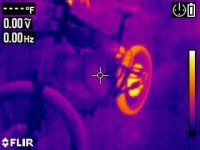After abusing my hub motor until it was too hot to touch, I started looking at whether I should add a little more Statorade. Per the recommendation, I originally added 8ml of the 10ml syringe. The recommendation also says up to 8ml for modest RPMs, and up to 12ml for higher RPMs, but that too much can cause drag (paraphrasing). My motor has modest RPMs, but don't know if 10ml would cause too much drag, but per their graphs, it looks like the incremental drag between 8ml and 10ml looks to be minimal. The graphs also show that the increase in heat conductivity between the two is even less.
I'm not really interested in adding hubsinks, but checked out what additional cooling might be gained by looking at the simulator. Using the MXUS 3005 as the example, since the simulator tests the motor, the motor with Statorade, and Statorade and hubsinks, it gives a good idea of the effect of each.
Adding Statorade alone provides a (dramatic) 48% improvement in shedding the heat. Statorade and hubsinks provides 53%, so 5% additional cooling relative to Statorade alone. The simulator doesn't model hubsinks alone, since that would only provide a negligible improvement, if any.
My conclusion is that it won't hurt (much) to add the additional 2ml of Statorade, and hubsinks aren't worth enough to do much for my case, so taming my throttle hand is probably the best solution, aside from adding a temp sensor to my motor. Anyone experience any downside to this?
Statorade, and Statorade plus hubsinks:

https://ebikes.ca/tools/simulator.html?motor=MX3005&batt=cust_72_0.05_24&cont=cust_70_200_0.03_V&hp=0&axis=mph&frame=mountain&autothrot=false&throt=100&grade=0&cont_b=cust_70_200_0.03_V&motor_b=MX3005_Sinks&batt_b=cust_72_0.05_24&hp_b=0&bopen=true
I'm not really interested in adding hubsinks, but checked out what additional cooling might be gained by looking at the simulator. Using the MXUS 3005 as the example, since the simulator tests the motor, the motor with Statorade, and Statorade and hubsinks, it gives a good idea of the effect of each.
Adding Statorade alone provides a (dramatic) 48% improvement in shedding the heat. Statorade and hubsinks provides 53%, so 5% additional cooling relative to Statorade alone. The simulator doesn't model hubsinks alone, since that would only provide a negligible improvement, if any.
My conclusion is that it won't hurt (much) to add the additional 2ml of Statorade, and hubsinks aren't worth enough to do much for my case, so taming my throttle hand is probably the best solution, aside from adding a temp sensor to my motor. Anyone experience any downside to this?
Statorade, and Statorade plus hubsinks:

https://ebikes.ca/tools/simulator.html?motor=MX3005&batt=cust_72_0.05_24&cont=cust_70_200_0.03_V&hp=0&axis=mph&frame=mountain&autothrot=false&throt=100&grade=0&cont_b=cust_70_200_0.03_V&motor_b=MX3005_Sinks&batt_b=cust_72_0.05_24&hp_b=0&bopen=true



